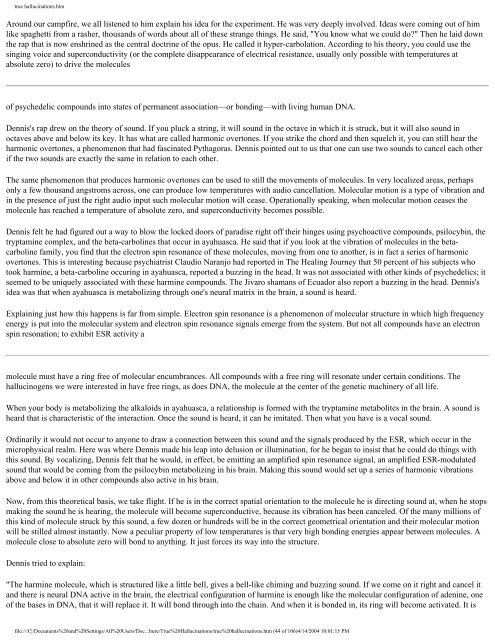You also want an ePaper? Increase the reach of your titles
YUMPU automatically turns print PDFs into web optimized ePapers that Google loves.
<strong>true</strong> <strong>hallucinations</strong>.<strong>htm</strong><br />
Around our campfire, we all listened to him explain his idea for the experiment. He was very deeply involved. Ideas were coming out of him<br />
like spaghetti from a rasher, thousands of words about all of these strange things. He said, "You know what we could do?" Then he laid down<br />
the rap that is now enshrined as the central doctrine of the opus. He called it hyper-carbolation. According to his theory, you could use the<br />
singing voice and superconductivity (or the complete disappearance of electrical resistance, usually only possible with temperatures at<br />
absolute zero) to drive the molecules<br />
of psychedelic compounds into states of permanent association—or bonding—with living human DNA.<br />
Dennis's rap drew on the theory of sound. If you pluck a string, it will sound in the octave in which it is struck, but it will also sound in<br />
octaves above and below its key. It has what are called harmonic overtones. If you strike the chord and then squelch it, you can still hear the<br />
harmonic overtones, a phenomenon that had fascinated Pythagoras. Dennis pointed out to us that one can use two sounds to cancel each other<br />
if the two sounds are exactly the same in relation to each other.<br />
The same phenomenon that produces harmonic overtones can be used to still the movements of molecules. In very localized areas, perhaps<br />
only a few thousand angstroms across, one can produce low temperatures with audio cancellation. Molecular motion is a type of vibration and<br />
in the presence of just the right audio input such molecular motion will cease. Operationally speaking, when molecular motion ceases the<br />
molecule has reached a temperature of absolute zero, and superconductivity becomes possible.<br />
Dennis felt he had figured out a way to blow the locked doors of paradise right off their hinges using psychoactive compounds, psilocybin, the<br />
tryptamine complex, and the beta-carbolines that occur in ayahuasca. He said that if you look at the vibration of molecules in the betacarboline<br />
family, you find that the electron spin resonance of these molecules, moving from one to another, is in fact a series of harmonic<br />
overtones. This is interesting because psychiatrist Claudio Naranjo had reported in The Healing Journey that 50 percent of his subjects who<br />
took harmine, a beta-carboline occuring in ayahuasca, reported a buzzing in the head. It was not associated with other kinds of psychedelics; it<br />
seemed to be uniquely associated with these harmine compounds. The Jivaro shamans of Ecuador also report a buzzing in the head. Dennis's<br />
idea was that when ayahuasca is metabolizing through one's neural matrix in the brain, a sound is heard.<br />
Explaining just how this happens is far from simple. Electron spin resonance is a phenomenon of molecular structure in which high frequency<br />
energy is put into the molecular system and electron spin resonance signals emerge from the system. But not all compounds have an electron<br />
spin resonation; to exhibit ESR activity a<br />
molecule must have a ring free of molecular encumbrances. All compounds with a free ring will resonate under certain conditions. The<br />
hallucinogens we were interested in have free rings, as does DNA, the molecule at the center of the genetic machinery of all life.<br />
When your body is metabolizing the alkaloids in ayahuasca, a relationship is formed with the tryptamine metabolites in the brain. A sound is<br />
heard that is characteristic of the interaction. Once the sound is heard, it can be imitated. Then what you have is a vocal sound.<br />
Ordinarily it would not occur to anyone to draw a connection between this sound and the signals produced by the ESR, which occur in the<br />
microphysical realm. Here was where Dennis made his leap into delusion or illumination, for he began to insist that he could do things with<br />
this sound. By vocalizing, Dennis felt that he would, in effect, be emitting an amplified spin resonance signal, an amplified ESR-modulated<br />
sound that would be coming from the psilocybin metabolizing in his brain. Making this sound would set up a series of harmonic vibrations<br />
above and below it in other compounds also active in his brain.<br />
Now, from this theoretical basis, we take flight. If he is in the correct spatial orientation to the molecule he is directing sound at, when he stops<br />
making the sound he is hearing, the molecule will become superconductive, because its vibration has been canceled. Of the many millions of<br />
this kind of molecule struck by this sound, a few dozen or hundreds will be in the correct geometrical orientation and their molecular motion<br />
will be stilled almost instantly. Now a peculiar property of low temperatures is that very high bonding energies appear between molecules. A<br />
molecule close to absolute zero will bond to anything. It just forces its way into the structure.<br />
Dennis tried to explain:<br />
"The harmine molecule, which is structured like a little bell, gives a bell-like chiming and buzzing sound. If we come on it right and cancel it<br />
and there is neural DNA active in the brain, the electrical configuration of harmine is enough like the molecular configuration of adenine, one<br />
of the bases in DNA, that it will replace it. It will bond through into the chain. And when it is bonded in, its ring will become activated. It is<br />
file:///C|/Documents%20and%20Settings/All%20Users/Doc...lture/True%20Hallucinations/<strong>true</strong>%20<strong>hallucinations</strong>.<strong>htm</strong> (44 of 106)4/14/2004 10:01:15 PM












